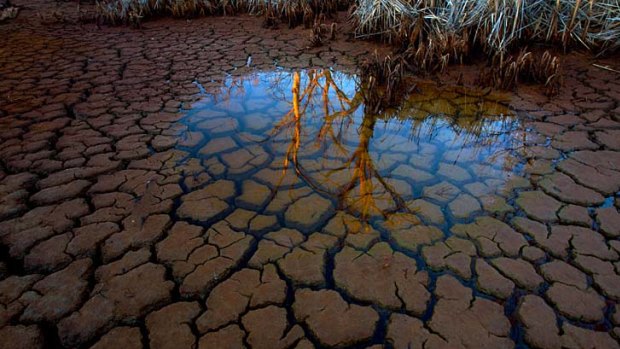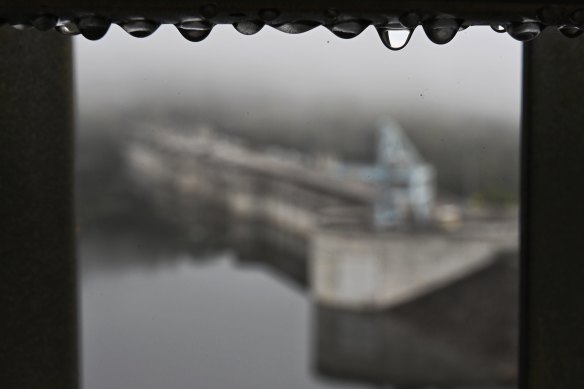Save articles for later
Add articles to your saved list and come back to them any time.
As summer draws nearer, so too are our plans to spend time at the beach or by a pool. But water experts are getting increasingly nervous about a problem that’s been lying dormant for years: our water supply is running out.
And it seems the problem will get worse as climate change triggers more intense and frequent extreme weather, and our population booms.
Sydney might not have enough water in the coming years as it battles climate change and population growth.Credit: Nick Moir
Dr Jamie Pittock, a flooding and climate change expert at Australian National University, says governments and water supply agencies haven’t kept as close an eye on the underlying issue as they needed to. In turn, alternative water sources haven’t been developed as quickly.
“Anything in the water-management space is expensive, and governments are reluctant to do something radically new or expensive in this field unless they have to,” he said. “But with ongoing climate change, we are going to have to get much better at managing under conditions of uncertainty and change.”
The problem is that to fill its dams, Sydney relies heavily on rainwater, which is then used for drinking water. But as these dry up, our water supply dwindles. Add the impacts of climate change and more extreme fires, droughts and floods – and water supply becomes a lot less reliable.
After three years of heavy rain, Warragamba Dam is at 95 per cent capacity – but can its water supply last the coming hot weather?Credit: Nick Moir
The Greater Sydney Water strategy, published in 2021, shows by 2060, the city’s water needs will increase by 250 gigalitres of drinking water per year – that’s equivalent to about half the volume of Sydney Harbour.
But we’re unlikely to have enough water to meet demand, says Stuart Khan, a professor at the University of NSW and on the Independent Metropolitan Water Advisory Panel.
“Our demands already exceed our supply. We haven’t done enough,” he says.
The report notes Sydney will need to find alternative sources that don’t rely on rainfall, ensure urban environments can better absorb water, and protect waterways and the natural environment.
The first is one of our biggest challenges. Sydney gets most of its drinking water from dams, with the Warragamba Dam supplying 80 per cent. Sydney’s dams are at 92 per cent storage capacity thanks to three years of heavy rainfall.
But pockets of NSW are showing signs of drought, and it won’t take long for this supply to wane. Already, 8.4 per cent of the state is drought affected, including regions like Grafton and Casino.
During the 2018-2020 drought, Sydney’s total water storage dropped from just above 80 per cent capacity to 40 per cent. Khan says we could see this again in future droughts.
“Trying to store enough water hasn’t worked for us. Storing water can be great, for getting us through seasons – from a few wet years to a few dry years – but the whole thing falls apart when there are many dry years,” Khan says.
In short, the way Sydney’s water system is designed means we won’t have enough water.
“We need to build more desalination plants, which are great for supplying water to coastal areas, but we need to also be thinking about how to get water to our most increasing demand areas, which will be in western Sydney. That will be the challenge. We can’t pump water from the coast to western Sydney: it would have to go under roads, under an entire city. That is simply not a realistic option.”
Globally, the year has already been marked by extremely high temperatures, likely to be accelerated by a looming El Nino and climate change. With summer just around the corner, authorities will be bracing for difficult conditions.
Turning on the tap to other solutions
Sydney has few alternative water sources. There’s a desalination plant in the south that turns salt water into fresh water, which produces about 15 per cent of our drinking supply. A Sydney Water spokesperson said it was supplying more water from the desalination plant under new operating rules, boosting supply by an additional 20,000 million litres on average.
The plant has the capacity to be scaled up and produce more water – but it’s not enough.
Pittock says Sydney has been lucky its dam supply has supported it for so many years. Cities like Perth and Melbourne have been forced years ago to diversify.
“Now it is Sydney’s turn, and it is going to be a challenge,” he says.
Another option is turning stormwater and sewage into clean water. Many cities do this, including Singapore. By 2060, the Asian city anticipates 85 per cent of its water demand will be met by sewage water and desalination. California is exploring plans to do the same.
“We need to think more broadly about how we diversify beyond seawater desalination,” Khan says. “When we have a drought and there is no rain, we suffer directly. The dams stop filling up and there are water restrictions, and we run out of water. It’s a cycle Sydney will continue until there’s increased water supply.”
Dr Ian Wright, who lectures in water science and management at Western Sydney University, says while pockets of Sydney use treated sewage water, there’s been no real urgency to adopt the method widely.
He adds that our obsession with using clean water for everything – like cleaning the car or watering the garden – could be contributing to overuse. Using grey water – water from the shower or washing machines – could be a good example of recycling water.
Hotter, drier and less water
There has been a shift towards drier conditions across the southwest and southeast of Australia, with more years recording below-average rainfall. For example, between April and October, there has been a decline in about 15 per cent of rainfall since 1970 for the region. Meanwhile, it’s getting hotter, which means rain evaporates quickly rather than flowing into the catchment.
This poses issues for a city heavily reliant on rainfall for its water supply.
After three years of wet weather, planning for a drought seems odd – but Wright says it’s precisely what we should be doing. “We need to be using this time to be building and improve our recycling and desalination,” he says. “[Only] when it gets dry do we start to panic.”
A three-year audit of the city’s water supply found it is unlikely to remain healthy, with climate change posing a massive risk to supply. The audit, undertaken by Eco Logical Australia and Restore Environmental Consultants for NSW Minister for Water Rose Jackson, looked at the health of the catchment between 2019 and 2022.
The report noted that while some areas were in good health, many featured degraded landscapes and wetlands, with poor vegetation, pollution and poor water quality.
It also noted that it was unlikely good land management practices and pollution regulation would maintain Sydney’s drinking water catchment health, unless substantial effort was made to reduce greenhouse gas emissions and limit climate change impacts.
Jackson said the government was not only committed to shoring up water supply but also addressing climate change and the environment.
She said that’s why as of next year, a new government department, to be known as the Department of Climate Change, Energy, the Environment and Water, would focus solely on this area.
“The former government set us on a path that has been hard to wind back. After a decade of neglect and inaction, we are working fast to address these issues and remain committed to meeting our net zero targets, which we will also establish in law,” she said.
“We know our regional communities always bear the brunt of devastating droughts and it is crucial they are given the resources and infrastructure to improve water security at the local level to ensure they can survive dry times.”
Despite the challenges, Pittock’s hopeful more water resources will be found.
“We have to. There is no alternative. The state government is focused on the fact that allowing a city to run out of water is not a strategy,” he says.
Get to the heart of what’s happening with climate change and the environment. Our fortnightly Environment newsletter brings you the news, the issues and the solutions. Sign up here.
Most Viewed in Environment
From our partners
Source: Read Full Article




